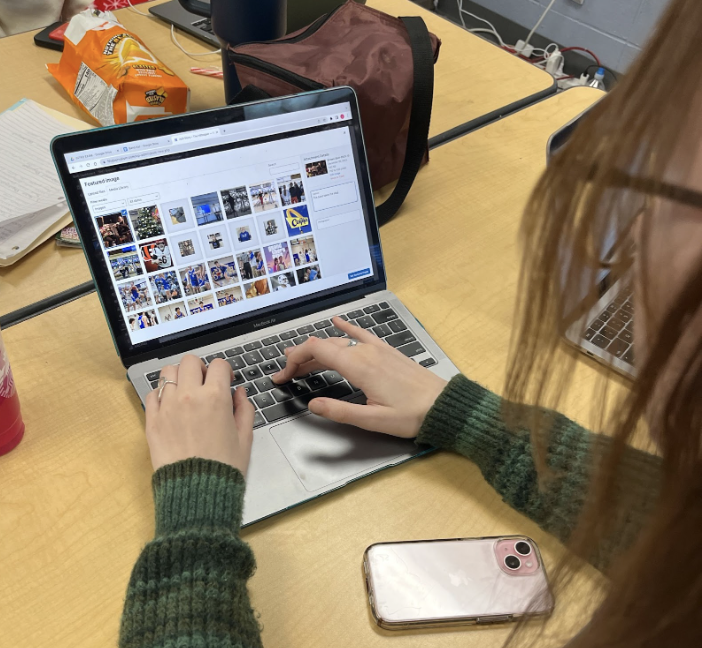High school journalism at Highlands evolves with media, technology, and cultural shifts, moving from traditional newspapers to dynamic digital platforms. This transformation presents challenges and opportunities for aspiring young journalists in today’s rapidly changing landscape.
Former Journalism Advisor Diana McGhee taught a single-section class for first-year students and experienced veterans from 2008-09 to 2017-18 school years. The first semester focused on teaching journalism history, design, and writing, while the second semester focused on content creation and collaboration.
Every day is a little bit different for the 2023-24 Publications class. The one constant, however, is when Editor-in-Chief Treiston Collins gives a two-minute warm-up speech at the beginning of class. He gives everyone a heads-up on upcoming events, as well as deadlines on yearbook spreads and other important notes. Afterwards, he uses his free time to check in with almost everyone just to get a general idea of the production day.
Collins said: “Even though I am the leader, I always check to see if my staff needs any help or for me to step in and work with them. My day is pretty simple, but it’s just because I’ve done this for so long.”
The transition from print to digital media has significantly impacted high school journalism, enabling interactive participation and reaching a larger audience. With this shift, the process of getting stories out has changed, but in some ways has stayed the same.
When asked about the writing process for the printed Hilltopper, McGhee said: “In a nutshell…brainstorming, assigning, writing, revising, publishing.”
The class produced eight annual newspapers for students, printing one every 4.5 weeks, using local printer Newforms for quick turnarounds. To streamline distribution, McGhee implemented “Organized Chaos Day,” where students counted newspapers for homeroom distribution. McGhee personally reviewed, edited, and approved content, ensuring final responsibility.
Hilltopper is an online platform that showcases staff members’ work through content, including quotes, photos, and sources. The process starts with the author, who incorporates these elements. The article is then edited by one of six editors, reviewed by the writer, and forwarded to the Managing Editor, Emme Orme, for publication.
The platform operates under Iwoa v. DeMoines for protection, but certain topics remain restricted. The article turnaround time is five days, including composition, editing, and posting, while photo galleries have a two-day turnaround.
Hilltopper Editor Jade Sandmann said: “In the first semester of the 2023-2024 school year, 153 things were posted on the Hilltopper…Basecamp is new to us this year and it is what we use to assign and organize articles. This has helped improve communication and how many things are posted.”
Digital journalism has revolutionized high school journalism by allowing students to use images, interviews, and other information sources, improving their writing experience and skill development. Technology and social media have increased awareness of important topics, transforming high school publications into advocacy platforms.
Students mostly used email for interviews outside the school, but McGhee mandated face-to-face interviews for school-related articles. She promoted resourcefulness and encouraged students to seek help for interviews. With over 30 years of experience in the Fort Thomas community, McGhee’s extensive network made her a valuable resource for students seeking information.
Our current process remains largely unchanged. We continue to conduct face-to-face interviews with individuals within the building, capturing their responses via audio recording on our phones. For interviews outside the district, we still rely on email, but also phone calls to coordinate.
In September, McGhee and her students held a distribution event for the previous year’s yearbooks. They set up a table in the front foyer, distributing them each morning for one week. Unclaimed yearbooks were delivered to first-period classes by Friday. The principal’s secretary, Mrs. Geiger at the time, distributed graduating senior yearbooks on behalf of the teacher and students.
The procedure of distributing yearbooks remains similar. Publications set aside one day each year to distribute yearbooks to students. Each student who purchased a yearbook is given a ticket including their name and other information, which they must provide to collect their yearbook. Pick-up days are frequently scheduled separately for people who were unable to attend the initial day. Yearbooks for graduating seniors are shipped to the home address provided to Publications the previous year.
Orme said: “At first yearbook distribution is stressful trying to figure out who gets what yearbook. But, it’s all worth it when you get to see everyone’s reaction to the spreads!”
High school journalism has evolved due to media, technology, and culture changes. The shift from print to digital platforms has presented challenges but also opportunities. The Hilltopper’s transformation has empowered students to engage with a wider audience and explore innovative storytelling methods. Technology integration and social media have streamlined production and enhanced communication. High school journalism remains dynamic, focusing on quality content and reader reactions.




